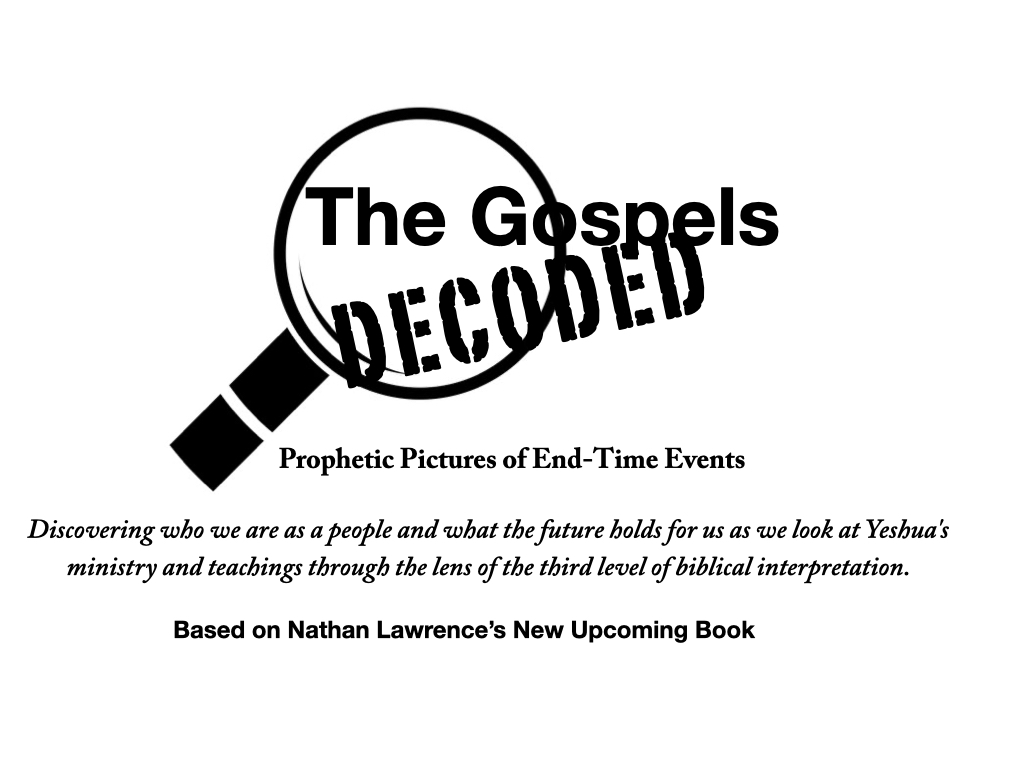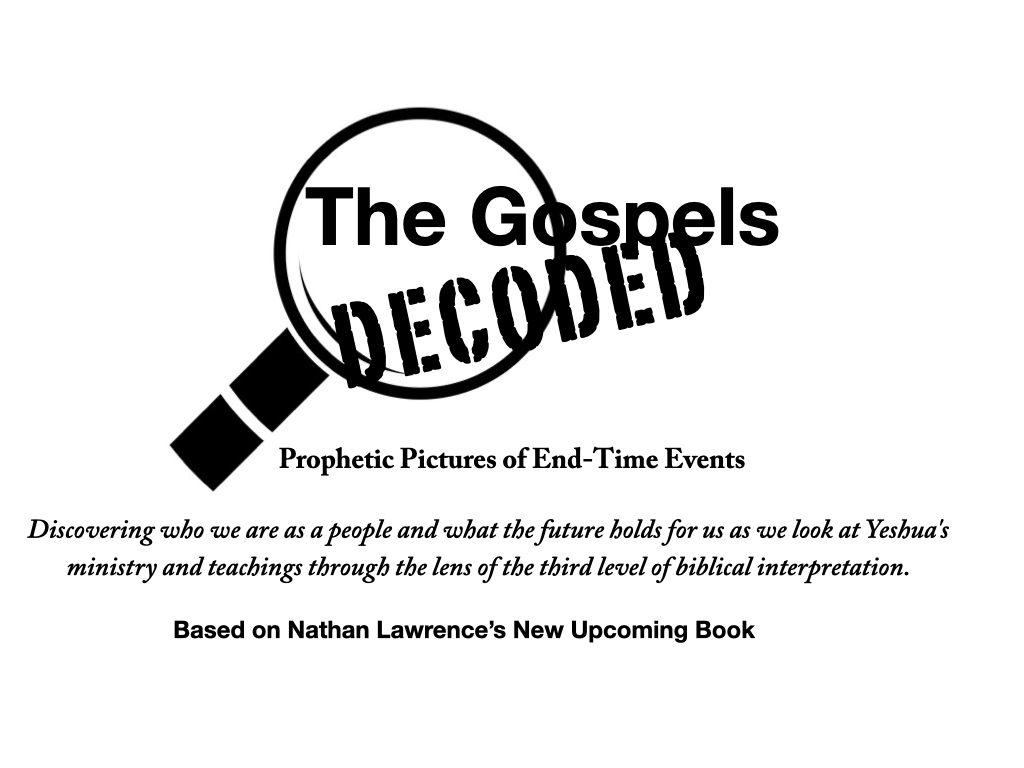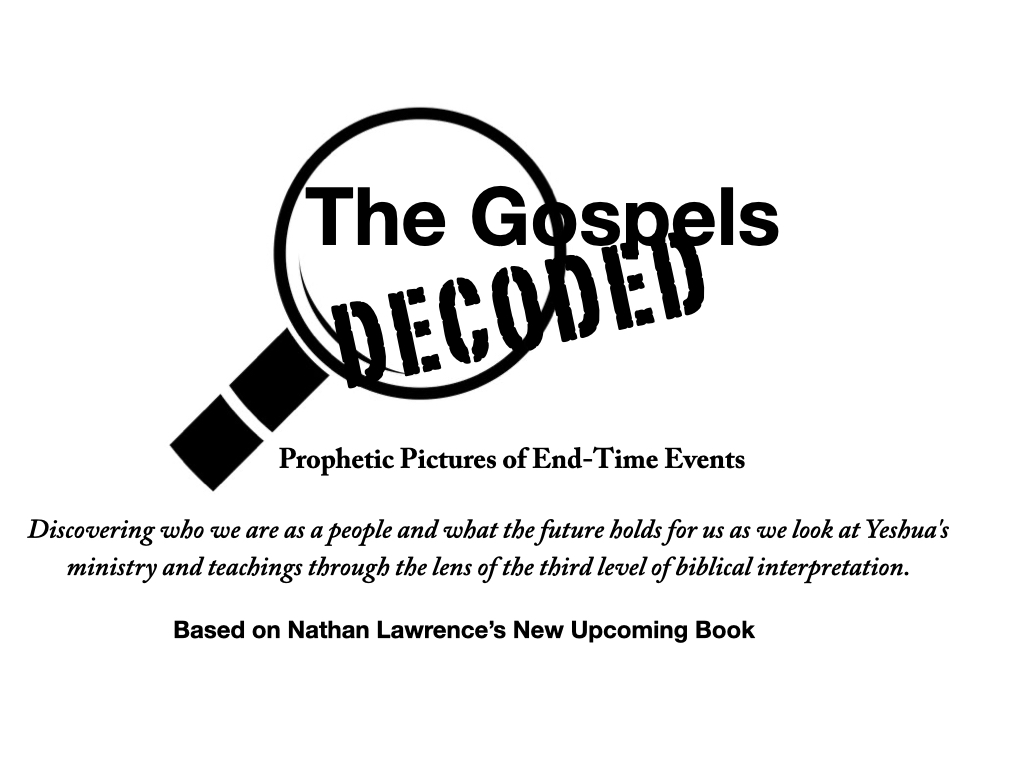
This author believes that the earthly ministry of Yeshua had prophetic implications pertaining to end time events. In other words, I will now attempt to show the reader that behind, if you will, the literal events surrounding Yeshua’s earthly ministry including his miracles and teachings, there was an entire prophetic or allegorical subtext or message. Yeshua’s life was literally a walking prophetic shadow-picture. Understanding these divinely engineered, yet hidden clues from a Hebraic context will yield a literal treasure trove of understanding into end time events as prophetically prefigured in the fall festivals of YHVH.
For the record, let it be known that such a study in no way denies the historicity of the literal events surrounding Yeshua’s life. Both Jewish and Christian scholars have been interpreting literal biblical events in an allegorical light for thousands of years. This is not a new exercise. (For a discussion of this, please refer to our brief study of the Jewish rules of biblical interpretation at the end of this book.) Not only have the biblical exegetes derived understanding from the biblical record through this means of interpretation, but numerous examples can be cited from the apostolic writers themselves interpreting various scriptural passages from the Tanakh (Hebrew Scriptures or Old Testament) in this manner as well.
What is different about the following study is that it will allegorically examine the entire life of Yeshua—his ministry activities, the meaning of the geographical names of the places where he ministered and his parables for the purpose of deriving insights into end time events such as the great tribulation and wrath of Elohim periods, the resurrection, the second coming, the regathering and reunification of the exiled Israelites, the marriage of the Yeshua to his bride and the establishment of his kingdom on earth. It is hoped that the insights gained may clarify some of the difficult passages in the writings of the prophets of the Hebrew Scriptures as well as the prophecies found in the Testimony of Yeshua including the Book of Revelation.
Yeshua Ministers to a Great Multitude
Matthew 4:23–25, And Yeshua went about all Galilee, teaching in their synagogues, and preaching the gospel of the kingdom, and healing all manner of sickness and all manner of disease among the people. And his fame went throughout all Syria, and they brought unto him all sick people that were taken with various diseases and pains, and those which were demonized, and those who were epileptic, and those that were paralytic; and he healed them. And there followed him great multitudes of people from Galilee, and from Decapolis,103 and from Jerusalem, and from Judea, and from beyond Jordan.
Prophetic Points to Analyze
- verse 23— all Galilee
- verse 23— preaching the gospel of the kingdom
- verse 23— healing all manner of sickness and disease
- verse 25— great multitudes
- verse 25— Decapolis
- verse 25— Judea
- verse 25— beyond Jordan
Yeshua ministered with miraculous healing power to those from the region of Galilee in northeastern Israel (the ancient territory of Ephraim in the Northern Kingdom of the house of Israel) to the area of Decapolis (meaning “ten cities”) east of the Jordan River. This is a possible allegorical if not a prophetic reference to the ten tribes of the Northern Kingdom of Israel, some of whose lands were located east of the Jordan River.
At the end of this present age just prior to and at the return of Messiah Yeshua as well as after the return of Yeshua, those Jews and Ephraimites returning to the Promised Land from the nations of their captivity (“beyond [or east of] the Jordan [River],” verse 25—a reference to Babylonia and Assyria where the Southern and Northern Kingdoms were exiled respectively)—will be returning broken, wounded, sick and demonized. They will need physical and spiritual healing (see the prophecy of Ezek 34). The regathering of lost Israel was Yeshua’s main ministry focus at his first coming (or advent), and is a mission that will be completed after his second advent. This end time or final regathering of lost Israel will occur during the time period that many Jewish sages refer to as the “final redemption” (when Messiah returns, the resurrection of the saints will occur, and Messiah will establish his kingdom upon this earth). At this future time, the regathering of the exiled twelve tribes of Israel will swing into full gear.
In the Gospel narrative, Matthew chapter four records that “great multitudes”followed Yeshua out of Galilee (verse 25), which, again, was the historic region of the Northern Kingdom comprising of the ten tribes of Israel.
Multitudes from this region of the ten tribes of Israel following Yeshua is a prophetic picture of what will happen in the future. Both the prophet Isaiah and Matthew the Gospel writer use the term “Galilee of the nations” (goyim or Gentiles, Isa 9:1; Matt 4:15) in reference to the Israelite tribes that had settled east of the Jordan River. The Bible writers also use this term in reference to the fact that those of the house of Israel would be scattered among the Gentile nations as part of their punishment for forsaking the Elohim (God) of Israel and the covenant they had made with him at Mount Sinai.
Likewise, prophetically at the time of Messiah Yeshua’s second advent, a final regathering of the Israelite exiles will occur from the nations of the world where they have been scattered. Multitudes will come to Yeshua as we see in the Book of Revelation (Rev 7:1–17) where John, under the inspiration of the Spirit of Elohim, prophesies about the 144,000 righteous saints sealed from all twelve tribes of Israel. After this, John speaks of the ingathering of the exiles and describe this momentous and long-awaited event as follows (verses 9–17),
“After this I beheld, and, lo, a great multitude, which no man could number, of all nations, and kindreds, and people, and tongues, stood before the throne, and before the Lamb, clothed with white robes, and palms in their hands; and cried with a loud voice, saying, ‘Salvation to our Elohim who sits upon the throne, and unto the Lamb.’ And all the angels stood round about the throne, and about the elders and the four beasts, and fell before the throne on their faces, and worshipped Elohim, saying, ‘Amein: blessing, and glory, and wisdom, and thanksgiving, and honor, and power, and might, be unto our Elohim for ever and ever. Amein.’ And one of the elders answered, saying unto me, ‘What are these which are arrayed in white robes and whence came they?’ And I said unto him, ‘Sir, you know.’ And he said to me, ‘These are they which came out of great tribulation, and have washed their robes, and made them white in the blood of the Lamb. Therefore are they before the throne of Elohim, and serve him day and night in his temple, and he that sits on the throne shall dwell among them. They shall hunger no more, neither thirst any more; neither shall the sun light on them, nor any heat. For the Lamb which is in the midst of the throne shall feed them, and shall lead them unto living fountains of waters, and Elohim shall wipe away all tears from their eyes.’”
Prophetic Points to Analyze from Revelation 7:1–17
- verse 9— a great multitude…of all nations, and kindreds, and people, and tongues
- verse 14— which came out of great tribulation and have washed their robes … in the blood of the Lamb
- verse 16— they shall hunger no more
- verse 17— the Lamb…shall feed them
One may ask the question when does this regathering of exiled Israelites occur that John speaks about in Revelation? Is it strictly an end time event as the Jewish scholars see, or has it been occurring since the time of Yeshua’s first coming only to culminate after his return?
In that the rabbinic Jews refuse to recognize the first coming of Yeshua the Messiah they, by default, have placed the “final regathering” of lost and exiled Israel at the coming of Messiah just prior to “the Messianic Age” or Millennium.
In reality, by Yeshua’s own admission (see Matt 15:24), he began the regathering at his first coming, and commissioned his disciples to continue that mission (Matt 10:6 cp. Acts 1:8).
Zechariah, the prophet, saw this regathering occurring when he prophesied hundreds of years before the birth of Yeshua, “In those days…ten men of the nations shall take hold out of all languages of the nations, even shall take hold of the cloak of a Jew, saying, ‘We will go with you, for we have heard that Elohim is with you,’” (Zech 8:23). Yeshua said that salvation is of the Jews (John 4:22), and he is that Jewish man, and Jewish Savior, and all people must take hold of him spiritually to be brought to Elohim (John 14:6). Ten is the number of the tribes in the Northern Kingdom who were mixed among the Gentile nations after their deportation and captivity from the land of Israel. This prophecy was partially fulfilled on the day of Pentecost in Acts 2 when many from the nations placed their trust in their Jewish Messiah (Acts 2:9–11, 36–41). So Zechariah’s prophecy, along with that of John in Revelation 7, began to be fulfilled in the time of the apostles and has continued to this very day. It will culminate in what the Jews call the “final redemption” or the “Gathering of the Exiles.”
The message that Yeshua preached was called “the gospel”, which is an Old English word meaning “good news” (Matt 4:23). This mission not only involved healing the sick, comforting the afflicted, feeding the hungry, and giving drink to the thirsty, but also preaching “the good news of the kingdom of heaven” (Matt 4:17). Yeshua was that Good Shepherd about whom Ezekiel prophesied in Ezekiel 34, who would heal the sick and feed the hungry.
When Yeshua mentions preaching “the gospel of the kingdom” (Matt 4:23), to what kingdom is he referring? If he were coming again, this time as Messiah Son of David, to rule the earth during the Millennium or Messianic Age, as Ezekiel 37:24–25 indicates, ruling over a reunited Israel (i.e., both houses of Israel, or the whole house of Israel as Ezek 37:15–22 states), then what other kingdom is there except the kingdom of Israel, that is, one nation under King Yeshua Son of David (verses 22–25)? And that kingdom is comprised of people coming from all nations who have one thing in common: they have been washed in the blood of the Lamb (Rev 7:14) making them children of Abraham as Paul clearly states in Romans 4:16; 8:9, 11 and gain in Galatians 3:7, 9, 14, 28–29), and who are no longer Gentiles (Gal 3:28), but are Israelites as Paul describes it in Ephesians 2:11–13,
[I]n time past Gentiles [peoples of the nations] in the flesh, who are called Uncircumcision by that which is called the Circumcision in the flesh made by hands; that at that time you were without Messiah, being aliens from the commonwealth [citizenship] of Israel, and strangers from the covenants of promise, having no hope, and without Elohim in the world, but now in Messiah Yeshua you who sometimes were far off are brought near by the blood of Messiah.
Early in his earthly ministry, Yeshua began preparing the way for the reunification of the two kingdoms or houses of Israel and for his rulership over this reunited kingdom during the Messianic Age (or Millennium). The final redemption or regathering of Israel is an event for which the rabbinical Jews have been waiting (as testified in their writings) for thousands of years. They simply fail to recognize that their Messiah Son of David and the Christian “Jesus” or more properly, Yeshua, are one in the same Person.
Are you a part of this final regathering of lost Israelites returning to their heritage as the prophets Zechariah and Malachi (and many other biblical prophets, as well) prophesied would happen in the last days (Zech 8:23; Mal 4:1–6)?
What You Can Do
Are you the willing “victim” of some invisible hand that is guiding your heart and footsteps back to the ancient and original Hebraic roots of your Christian faith? For some unexplainable reason, are you beginning to take an interest in and to identify with the nation of Israel as well as to our Jewish brothers? If so, then you are a part of the final regathering that the Gospels refer to literally and prophetically as “multitudes from Galilee of the nations” that followed Yeshua. These are some of the same people about which John prophesies, who will come out of great tribulation in the last days in Revelation 7:9, 14.
With all of your heart, embrace the divine calling that YHVH has graciously and sovereignly tendered to you. Do not turn back form it! Ask Elohim what he would have you do to be part of his end-times spiritual program to help restore his people to their ancient spiritual heritage and their future destiny.
Yeshua Heals the Man With an Unclean Spirit in a Synagogue
Mark 1:21–28, 39, “And they went into Capernaum; and straightway on the Sabbath day he entered into the synagogue, and taught. And they were astonished at his doctrine, for he taught them as one that had authority, and not as the scribes. And there was in their synagogue a man with an unclean spirit; and he cried out, Saying, ‘Let us alone; what have we to do with you, Yeshua of Nazareth? Are you come to destroy us? I know who you are, the Set-Apart One of Elohim.’ And Yeshua rebuked him, saying, ‘Be quiet, and come out of him.’ And when the unclean spirit had torn him, and cried with a loud voice, he came out of him. And they were all amazed, insomuch that they questioned among themselves, saying, ‘What thing is this? What new doctrine is this? For with authority he commands even the unclean spirits, and they do obey him.’ And immediately his fame spread abroad throughout the entire region round about Galilee.…And he preached in their synagogues throughout all Galilee, and cast out devils.”
Prophetic Points to Analyze
- verse 21, Capernaum
- verse 21, synagogue
- verse 23, an unclean spirit
- verse 28, region round about Galilee
- verse 39, preaching in their synagogues…casting out demons
- verse 39, throughout all Galilee




